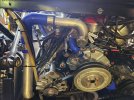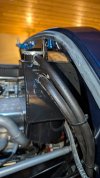Finally back at it for a little while. Fitting up these pipes in a tight space with the shifter cable and sensors wires was a serious frustrating pain. The sharp metal edges of the bulkhead panel did a number on my hands and arms (tore the skin off the middle joint of my dominate hand bird flipping finger).
The metal section was purchased from Hillbank and is supplied by SPF.
Here is what I have so far:

This picture is 90 degrees clockwise :

I used some u shapes auto trim to protect the hoses/pipe passing through the bulkhead.
I couldn't use the gates shrink clamps on some of the connections as they were too snug to get into place.
I wasted too much time trying to use silicone 5/8" 90 degrees hoses to the heater connections (one in the rear tunnel exit and one behind the thermostat housing). I ended up buying the proper 90 degrees 3/4" one end and 5/8" other end sections.
I have quite a few new leftover bits I will make available when this is all done.
I still need to fill the system and check for leaks ... maybe in a few days when I can bend my finger!
The metal section was purchased from Hillbank and is supplied by SPF.
Here is what I have so far:
This picture is 90 degrees clockwise :
I used some u shapes auto trim to protect the hoses/pipe passing through the bulkhead.
I couldn't use the gates shrink clamps on some of the connections as they were too snug to get into place.
I wasted too much time trying to use silicone 5/8" 90 degrees hoses to the heater connections (one in the rear tunnel exit and one behind the thermostat housing). I ended up buying the proper 90 degrees 3/4" one end and 5/8" other end sections.
I have quite a few new leftover bits I will make available when this is all done.
I still need to fill the system and check for leaks ... maybe in a few days when I can bend my finger!


